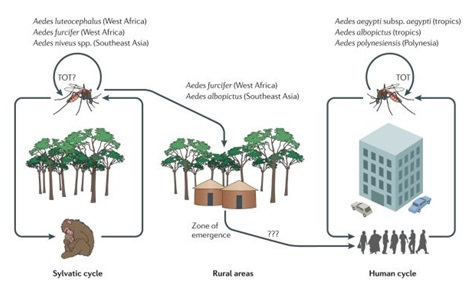作为一种传染病,蚊虫是登革热的主要传播媒介,其中伊蚊是传播登革热病毒的主要蚊种,包括埃及伊蚊和白纹伊蚊。患者和隐性感染者为主要传染源。患者在发病1日至发病后3日内传染性最强。少数患者在热退后第3日还可从血液中分离到病毒。此外蝙蝠、猴、鸟类和狗等动物体内可检测到登革热病毒抗体,可能为登革热病毒的自然宿主,从而有可能成为本病的传染源。在新流行区各年龄组均易感但以青壮年发病者居多【1】。
本病潜伏期2~15日,平均为6日左右。发病后可有发热、皮疹、出血、淋巴结肿大等表现,病后患者常感虚弱无力,完全恢复常需数周。重型登革热于病程第3~5日,出现头痛、恶心、呕吐、意识障碍,呈脑膜脑炎表现或有些表现为消化道大出血和出血性休克。本型常因病情发展迅速,因中枢性呼吸衰竭和出血性休克而死亡【2】。
登革热是一种具自限性倾向的传染病,无并发症患者的病程约为10天。本病通常预后良好,死亡病例多为重型患者。目前对本病尚无确切有效的病原治疗,主要采取支持及对症治疗措施【3】。

The transmission cycles of dengue virus【4】
参考文献:
1.Schaffner F1, Mathis A2.Dengue and dengue vectors in the WHO European region: past, present, and scenarios for the future.Lancet Infect Dis. 2014(14):70834-5.
2.Whitehorn J, Yacoub S, Anders KL, Macareo LR, Cassetti MC, Nguyen Van VC, Shi PY, Wills B, Simmons CP. Dengue Therapeutics,Chemoprophylaxis, and Allied Tools: State of the Art and Future Directions.PLoSNegl Trop Dis. 2014(8):e3025.
3.Remy MM. Dengue Fever: theories of immunopathogenesis and challenges for Vaccination.Inflamm Allergy Drug Targets. 2014,13(4):262-74.
4.Nikos Vasilakis,* Jane Cardosa,Kathryn A. Hanley, Edward C. Holmes,Scott C. Fever from the forest: prospects for the continuedemergence of sylvatic dengue virus and its impact on public health.Nat Rev Microbiol. 2011; 9(7): 532–541.



